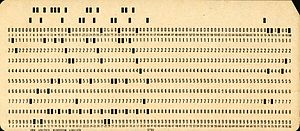Moore’s law is well known in the electronics industry; it states that the number of transistors roughly doubles every two years. Since 1965 Moore’s law has proven to be true and the capabilities of digital electronics has enjoyed an exponential growth in capability. The embedded systems industry has greatly benefited from the growth in capabilities with once cumbersome 8-bit microcontrollers being replaced by modern 32-bit capabilities. With the industries focus on hardware growth, the drastic increases in capabilities and the way in which firmware is being developed is largely being overlooked.
Since the dawn of the first computers, firmware has always been necessary to run the switching the component of the hardware. Firmware can be thought of as the yin to the hardware yang; they need to coexist with each other. In the early days firmware was developed and stored on punch cards. An example can be seen in Figure 1. The firmware was written to be functional with reuse or modularity not needed or possible.

Figure 1 – IBM Punchcard (Image Source: Wikipedia)
As the hardware capabilities evolved to include programmable flash, firmware moved from the tedious punch cards to being stored as binary information that could be loaded onto the microcontroller. Despite this leap in storage capabilities the firmware itself remained simplistic and functional. Right around 1973 the first version of the C programming language came into existence, which is still the primary programming language for embedded software.
The way in embedded software in the 80’s and 90’s was developed began to drastically change from a process and procedural point of view. As far as the firmware and the embedded system itself went, the software was nearly always developed from scratch and developed in a functional and non-object oriented way. Reuse and modularity was rare but slowly techniques were development that did allow for reuse and for very robust firmware to be development.
At the turn of the century and into the first decade, the way in which firmware was developed began to change rapidly. Even though the C language was still the primary tool for the embedded software developer, code was no longer written to just be functional but instead reusable. Modularity and reuse began to take center stage as development costs and consumer demands for product features began to rapidly rise. Developing firmware from scratch every time was no longer an option.
The way in which software is being developed today is silently going through a revolution due to the embedded software challenges facing developers. Microcontroller technology has evolved to the point from both an architectural speed and storage space standpoint that firmware developers can employ advanced development techniques. Code shouldn’t be written to be functional but instead use object-oriented techniques that maximize reuse, scalability and testability. The use of object-oriented techniques allows low-level firmware to be componentized and developed through either high level tools or through automated code generation. Using frameworks, components and layered architectural design patterns allow embedded software developers to abstract out the hardware and focus on the development of product features rather than focusing on how to make a peripheral perform the function it was designed to do. The shift to abstractions and high-level tools is silently revolutionizing the way that firmware is being developed. A decade from now firmware development may be nothing more than software integration, grabbing vendor and 3rd party components and meshing their APIs together to form a final system. Firmware design may seem to evolve much slower than its hardware counterpart, but the way in which firmware is being developed is going through its own silent revolution.
Originally Published 2015 on EDN.com





